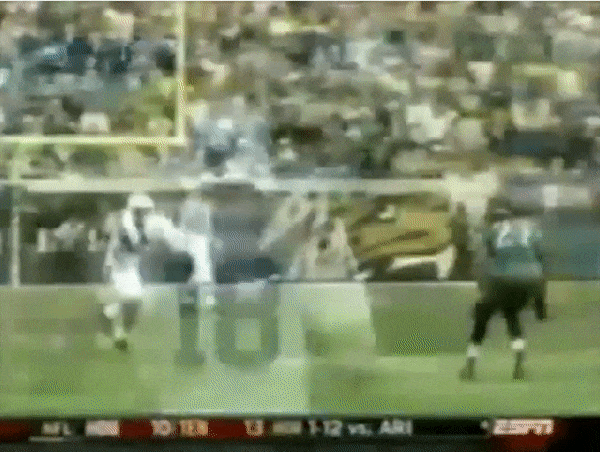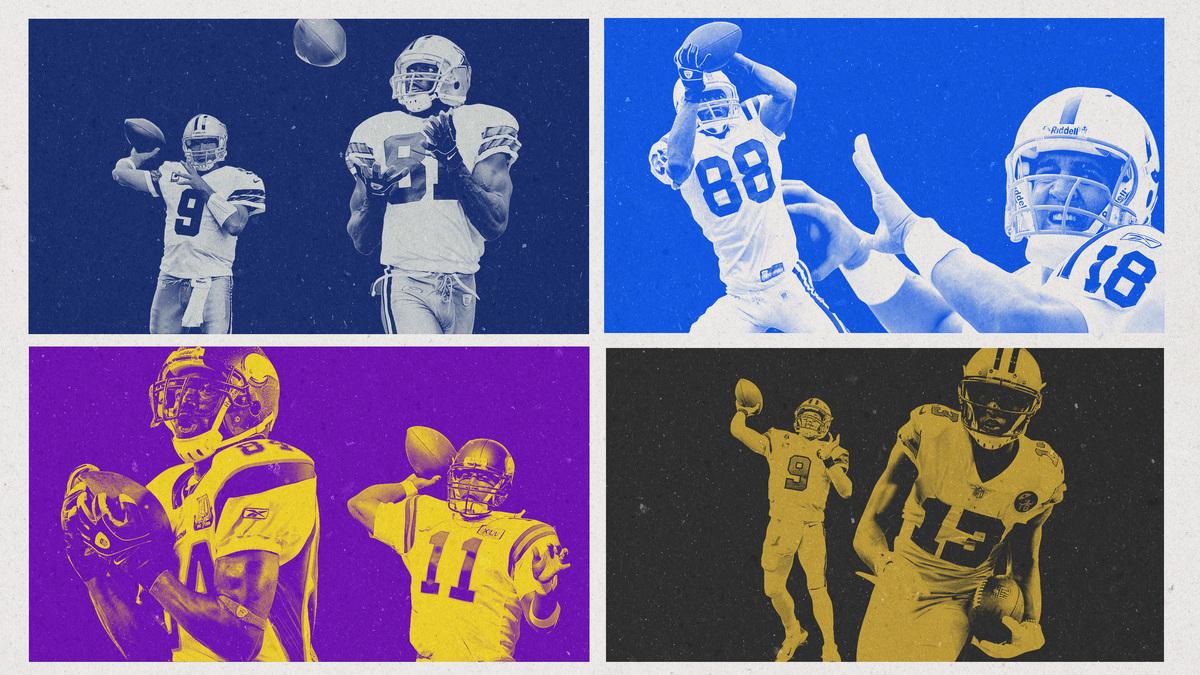The Top 10 NFL Quarterback–Pass Catching Duos of the 21st Century
There have been plenty of solid individual receiver, QB, and tight end performances since 2000, but from Randy Moss and Dante Culpepper to Tom Brady and Gronk, these are the duos who have defined the modern NFLDuring their first two full seasons together, Patrick Mahomes and Travis Kelce have emerged as one of the most dangerous quarterback–pass catcher combos in football. Both guys have rewired our expectations of their respective positions by putting up numbers that rival any in league history. With Kansas City’s dynamic duo in mind—and with nine more days to go until they play in the Super Bowl—I decided to use the off week to answer what initially seemed like a simple question: “What are the 10 best QB–pass catcher duos since the turn of the century?”
That time frame isn’t arbitrary. The league’s Golden Age of quarterbacks began when Peyton Manning was drafted in 1998—with Tom Brady (2000) and Drew Brees (2001) following shortly after. Considering the fact that two of those guys are somehow still in the league, the beginning of their careers seemed like a good starting point. (Also, it gave me an excuse to remind everyone just how ridiculous young Daunte Culpepper was.) Before we get to the rankings, though, a few ground rules: The pairings on this list had to spend at least three full seasons together. That means you won’t find the Mahomes-Kelce connection or the Deshaun Watson–DeAndre Hopkins partnership among this group. Also, no QB can appear more than once. So, apologies to Reggie Wayne, Antonio Gates, and Jimmy Graham: your QB gets a different dance partner this time around. But enough semantics. Let’s get to it.
10. Daunte Culpepper and Randy Moss, Vikings (2000-04)
There’s never been a quarterback-receiver pairing quite like Moss and Culpepper. They’re the most physically intimidating duo the league has ever seen. Standing 6-foot-4 with 4.25-second 40-yard dash speed, Moss is the scariest deep threat in NFL history. And at 6-foot-4 and 260 pounds, Culpepper was even more imposing—a QB in a tight end’s body. “Just the pure stature of the two guys was incredible,” says Titans tight ends coach Todd Downing. “To watch them and what they could do on a football field, those guys were just incredible freaks of nature.”
Downing started his coaching career as a football systems analyst with the Vikings in 2003, and he had a front-row seat to arguably the best deep-ball connection ever. “Daunte could throw the ball a country mile,” Downing says. “It was just a beautiful rainbow. Turned over perfectly. An absolutely gorgeous go ball.” Downing has worked with some cannon-armed QBs during his 15-plus years in the NFL (including Matthew Stafford), but he says that judging by pure distance alone, no one could chuck it quite like Culpepper. At times, it just seemed like he was launching the ball as far as he could, daring Moss to go get it. More often than not, he did. During their five seasons together, the pair connected on 20 touchdown passes of 30-plus yards (and 53 scores overall).
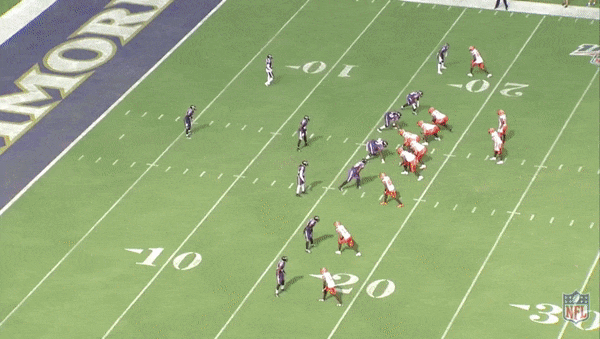
As Moss and Culpepper burned defenses to the ground, opposing coordinators started deploying increasingly bizarre coverages to try to slow them down. Downing remembers Green Bay using linebacker Na’il Diggs as a second defender to jam Moss at the line of scrimmage before rushing the passer. “Who does that?” Downing says. “It’s the most absurd scheme you can think of, just to disrupt Randy’s release. And they played him with a cloud corner. And a safety over the top. It was just crazy, some of the stuff that we were seeing.” In Downing’s second season, Minnesota visited Green Bay in a wild-card game that’s become infamous for Moss’s mooning celebration in the fourth quarter. The play that led to Moss dropping (fake) trou looked like a standard go route up the sideline, but Downing claims it was actually a run that Culpepper and Moss changed at the line of scrimmage. All those two needed was a little nod or wave, and six points were soon to follow. “They just had a synergy and a connection that allowed them to make some plays that were head scratchers even to the coaches,” Downing says.
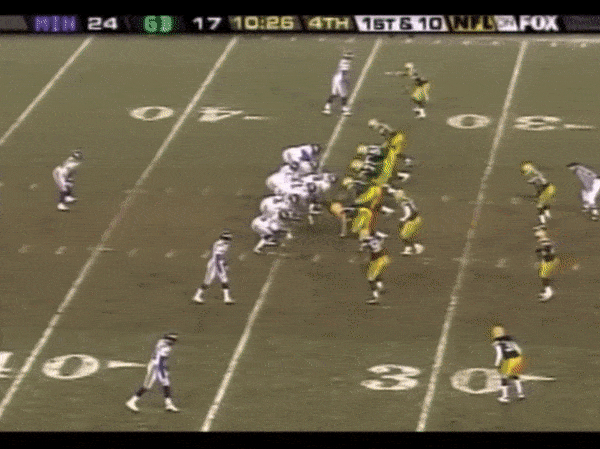
9. Tony Romo and Terrell Owens, (2006-08)
Romo got his first chance at quarterback for the Cowboys five games into T.O.’s first season in Dallas, and the two wasted no time in tearing cornerbacks to shreds. In the final 11 games of the Cowboys’ 2006 campaign, Owens hauled in nine touchdown catches and racked up 903 yards. And the beginning of a beautiful partnership was born.
Steelers wide receivers coach Ray Sherman has worked with some of the best receivers of all time. During his 30-year career, he’s coached Jerry Rice, Randy Moss, Donald Driver, and others. But none of them were built like Terrell Owens. At 6-foot-3 and 225 pounds, he looked like he was chiseled out of marble—but still had the acceleration of a much slimmer receiver. “He is probably the most physical guy that I’ve ever been around,” Sherman says. “And he was so explosive. I mean, it was scary.”
Sherman recalls a play against the Eagles during the 2007 season in which the Cowboys dialed up what they called a “four pump” to Owens on a third-and-10. The concept featured Owens running a curl-and-go in the middle of the field and Romo giving an exaggerated shoulder fake to bait the defensive back. “The safety from Philadelphia started driving on him, so he put his foot in the ground and went vertical,” Sherman says. “Tony just launched it and [Terrell] just walked it down.”
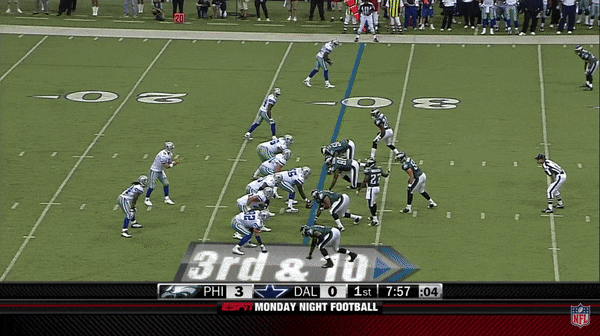
Few receivers have ever been able to throttle up to full speed like Owens, and that stop-and-start ability allowed him to wreak havoc on double moves. As was often the case at Owens’s many stops, the end was ugly in Dallas. By the close of their third year together, Romo and Owens’s relationship had deteriorated, and the enigmatic receiver was released after the 2008 season. But during their brief time together, those two made up the most high-octane tandem in the NFL.
8. Philip Rivers and Keenan Allen, Chargers (2013-19)
Allen and Rivers solidified their bond on a Monday night in 2013. Allen was a rookie at the time, and though he’d posted big numbers in the Chargers’ previous two games, his touchdown catch against the Colts in Week 6 was different. On a second-and-9 early in the second quarter, Allen ran a deep route down the left sideline and was blanketed by two defensive backs. Rivers unleashed a throw anyway. “I was just like, ‘Wow,’” Allen says. “The guts and the trust that he had on that one. I didn’t think I was gonna get to it. I didn’t know why he was throwing the ball. That throw was ridiculous.”
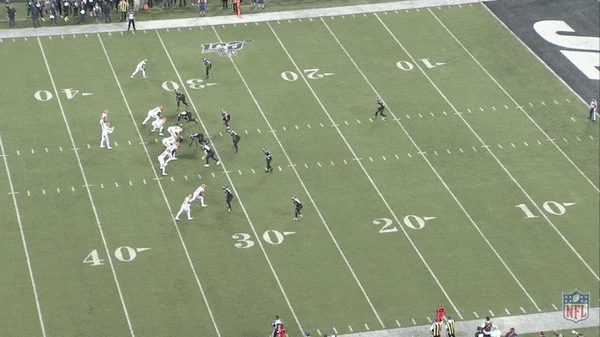
That 22-yard touchdown showed the belief that Rivers had in his first-year wideout, but it also exemplified the special connection between these two. Rivers and Allen may not have the historic production of other duos on this list, but their chemistry rivals any pairing in the NFL over the past 20 years. Look at where Allen is when Rivers lets that throw loose. From the end-zone camera view, you can’t even see him. That type of anticipation comes standard with these guys. “We used to be looking at the pictures after a series, and [former backup quarterback] Kellen Clemens would always tease [Rivers], ‘You don’t even need to look at these,’” says Colts offensive coordinator Nick Sirianni, who spent five years as a Chargers assistant. “‘Not only can you tell me what the front was, and what the coverage was, and what the blitz was. You’ll tell me what stance the corner was in, and you’ll tell me what condiments the guy put on his hot dog in the front row.’ [Philip] sees everything.”
Rivers is a football encyclopedia, and he and Allen share an unmatched understanding about the best ways to attack voids within specific zone looks. “I know what he likes against certain coverages,” Allen says. “I know where he wants to throw the ball before he even says ‘hike.’ Having that chemistry and understanding, where I know what my guy likes and he knows what I like. He knows how I look at the top of my route when I’m about to come out, even if I’m not turned around yet.”
Seven years into their partnership, Rivers and Allen have their own language. Allen is virtually unguardable on choice routes out of the slot, and that allows him and Rivers to play a two-man game that resembles a football pick-and-roll. “Nine times out of 10, I’m supposed to go a certain way, but we’ll change it up and he’ll let me do a juke move where I go left and then come back right,” Allen says. “He’ll tell me at the line of scrimmage, ‘Hey, this is the one we looked at on film.’”
Against the Chiefs in Week 1 of the 2018 season, Allen whispered a quick message to Rivers as he went in formation. “As I’m in my motion, I’m telling him, ‘If he presses me, I’m gone,’” Allen says. The result was an easy 20-yard touchdown. “Just the connection like that, the communication we have, and the way we can execute it, it’s money.”
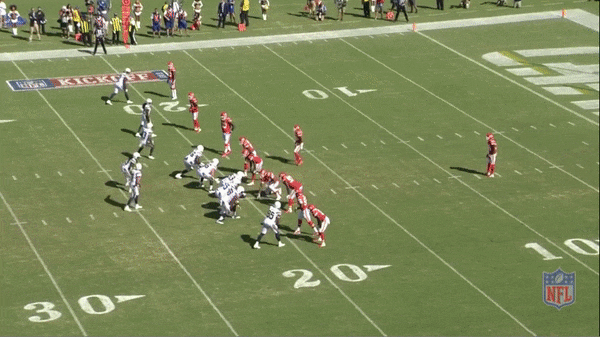
Allen and Rivers have tortured DBs with a variety of concepts over the years, but their bread and butter is the deep in route. After threatening vertically for about 20 yards, Allen snaps off the top of his route and sharply breaks flat inside. “It’s a winner versus every coverage,” Allen says. “And having a guy like Phil that can throw over guys and have it lay right where it’s supposed to go, with the timing and touch that he has, I don’t have to do much other than be there on time.” The play has become such a staple that now, even players on other teams recognize it as their trademark. “I remember last year in the Pro Bowl, me and Pat Mahomes connected on the same route,” Allen says, “and he said, ‘I laid it up there just like Philip.’”
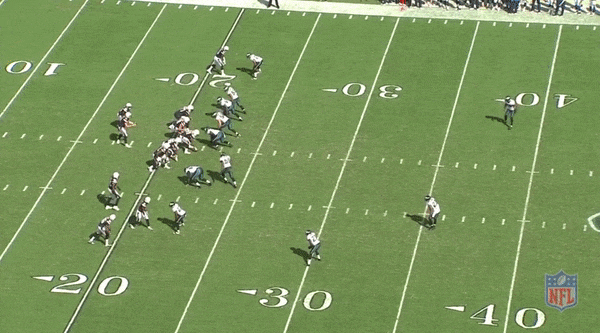
7. Kurt Warner and Larry Fitzgerald, Cardinals (2005-09)
It’s still shocking to consider the state of Kurt Warner’s career when he signed with Arizona in 2005. The former league MVP had been supplanted by Eli Manning as the Giants starter the previous year, and most of his offers that spring were to back up highly drafted QBs in places like Chicago and Detroit. It seemed like Warner’s best days were well behind him, but during his three full seasons as the Cardinals starter, he and Fitzgerald developed into a potent combination. “I think a special bond was created when Kurt came in with his pedigree, his experience level, his success, and his expertise, and his attention to detail,” says former Cardinals wide receivers coach and offensive coordinator Mike Miller. “I think that was the perfect type of person and quarterback to be introduced to Larry at that point in his career.”
Warner and Fitzgerald hooked up for 39 regular-season touchdowns during their time together, but their connection was never more electric than during Fitzgerald’s magical playoff run after the 2008 season. Over four games, Fitzgerald racked up 546 yards and seven touchdowns. It’s still the most dominant postseason stretch by a receiver in NFL history. It just didn’t seem to matter how Warner got him the ball. Against the Panthers in the divisional round, Fitzgerald fooled Carolina’s secondary so badly on a crossing route that All-Pro linebacker Jon Beason buried his face in his hands during the play.
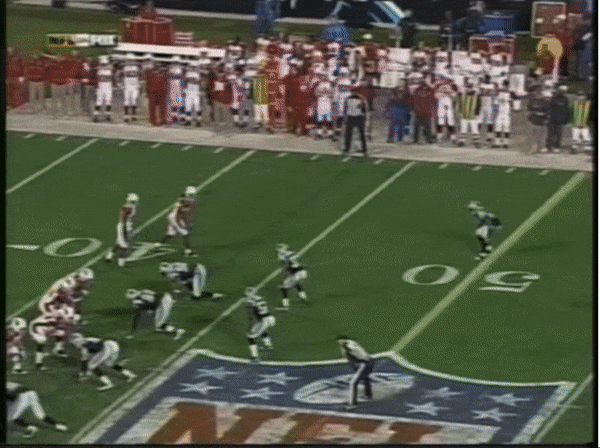
On a third-and-1 later in the game, Warner uncorked a throw into double coverage and watched as Fitzgerald leapt over both defenders and somehow came down with the ball. “The place where he has a tremendous advantage is when he’s running down the field and the ball is in the air,” Miller says. “His ability to adjust his body and be able to manipulate himself and make the adjustments in the air and bring it in, that’s definitely where he’s unparalleled. You feel good about putting it within his range, because if he’s on the move and a defender is trying to run with him and play the ball, you just can’t compete with Larry Fitzgerald.”
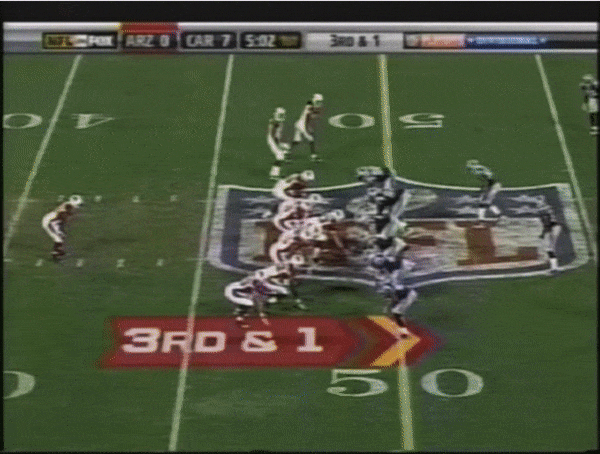
Fitzgerald may be the best jump-ball receiver the sport has ever seen. Randy Moss was more physically gifted, but Fitzgerald’s ability to contort and control his body in midair was unmatched. Miller points to Fitzgerald’s fade route touchdown against the Steelers in Super Bowl XLIII. As the ball arrives, Fitzgerald manages to turn his entire body back toward the cornerback while staying perfectly upright, to the point that he looks like a figure skater spinning in the air. Larry Fitzgerald was never covered, even when he was. And Warner knew it.
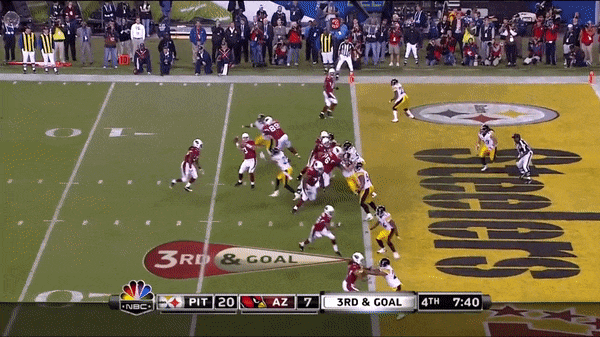
6. Matthew Stafford and Calvin Johnson, Lions (2009-15)
It’s not a stretch to say that the Lions’ record-setting duo is the most gifted QB-WR combination of all time. Megatron’s pre-draft numbers still don’t make sense. At 6-foot-5 and 239 pounds, Johnson ran a 4.35 in the 40 and recorded a 42.5-inch vertical leap. He might be the greatest pure athlete to ever grace an NFL field. During his first practice as Lions head coach, Jim Schwartz asked players to do some sprints, and Johnson was moving so fast, he created actual gusts of wind. “He’s flying by ya, and it’s taking him two steps to cover 5 yards,” says Downing, who also served as former Lions quarterbacks coach. “You’re just blown away by his size. You could feel him go by you.” Watching him on tape, it’s still hard to reconcile how a man that big could travel at that speed.
Stafford was no slouch, either. It felt like all the way back in high school, Stafford was destined to become a no. 1 pick in the draft. When Downing talks about the QB’s arm, he tosses the word “howitzer” around. “There’s not a single throw in the history of the game that [Matthew] can’t make with his arm talent,” Downing says. Arm strength is often overrated for NFL quarterbacks, but with the way defensive coordinators planned for Johnson, Stafford regularly needed every drop of hot sauce. Because most teams bracketed Johnson on nearly every play, Stafford’s throwing lanes were routinely smaller than the Death Star’s exhaust port. “When he needed to drill it into a spot and take the air out of it, get the ball there as fast as possible, he could put as much zip on a frozen rope as he wanted,” says Downing.
He points to a throw against the Cowboys in 2013 when Detroit was trailing late in the fourth quarter. On a first-and-10 from the Dallas 23-yard line, Stafford fired an absolute laser beam to Johnson up the right seam that brought the Lions inside the 1. “That ball never got higher than 6 feet off the ground and was probably traveling as fast as any ball he’s ever thrown,” Downing says.
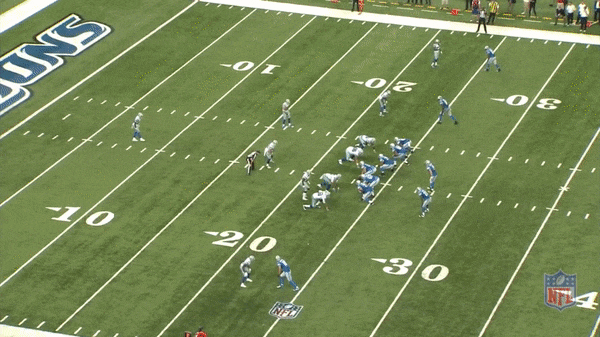
Downing worked closely with offensive coordinator Scott Linehan during their five years in Detroit, and over time, the pair realized that defenses were countering Megatron the same way they had another superstar receiver. “We started to say, ‘We’re getting the Randy Moss coverages,’” Downing says. “[Scott] would say, ‘You can throw this whole opponent breakdown out the window, because we’re not going to see any of this.’ We’d watch the last four games, and it’d be single-high [safety] or man, and it’d be, ‘Well, they’re not going to play Calvin like this.’” Defensive coordinators were terrified of Johnson beating them vertically so they’d often use a tactic that involved a cornerback playing “cloud” coverage way off Johnson with a safety also looming over the top. Rather than forcing throws down the field, the Lions were happy to carve up secondaries on lazy in-breaking routes to Johnson underneath. “We made a lot of hay on that concept over our five years there,” Downing says. “It was a shining example of Matthew’s trust that Calvin was going to get in there on time, Calvin’s trust that Matthew wasn’t going to throw him into a headache, and being able to manipulate a pass-stopping coverage.” During his peak, it didn’t seem to matter how many bodies defenses threw Johnson’s way. Even with the league’s recent passing boom, his single-season record of 1,964 receiving yards still stands.
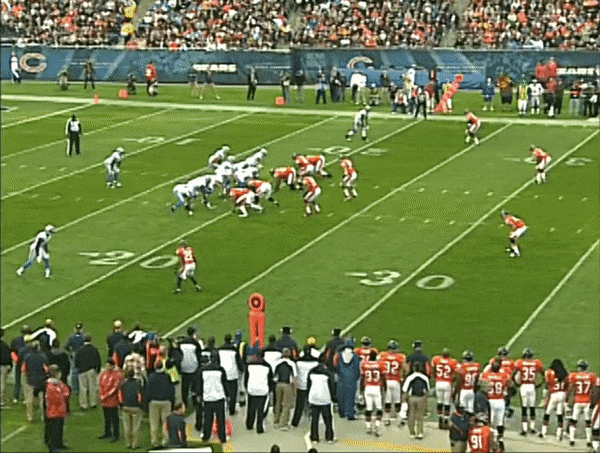
5. Matt Ryan and Julio Jones, Falcons (2011-19)
Over the past decade, no duo in football has been more reliable than Ryan and Jones. Since 2014, Jones has tallied at least 83 catches and 1,394 yards each season. During that stretch, he’s averaged a league-leading 102 yards per game. Julio’s greatness has never been all that complicated. He’s the receiver you’d build from scratch. Just look at his spider chart. Those measurements sound made up. But what truly sets Jones apart is that he’s so much more than a typical height-weight-speed receiver. “One of the most unique things about him is that despite his body frame, he has the quickness of a so-called prototype slot receiver,” says Falcons quarterback coach Greg Knapp. “His ability to get in and out of breaks at his size is uncanny.” Using Jones in the slot not only helps the Falcons offense stay unpredictable—it has the opposite effect on a defense. Against a superstar like Julio, defensive coordinators will often use coverages and tactics they haven’t deployed all season when he’s lined up on the outside. But when he’s in the slot, it becomes much harder to design ways to slow him down.
Ryan and Jones’s connection shines through most on late-breaking deep routes—ones that few pairings in the league would even attempt. Opposing cornerbacks live in constant terror that Jones will run right by them, and the Falcons use that fear to their advantage. Usually off a hard play-action fake, Jones will take off down the left sideline in what looks like a straight go route. About 20 yards into that sprint, he’ll stop on a dime and break hard toward the boundary. It’s like watching a car chase scene when one driver slams on the breaks and the other flies by. “There’s a threshold for a cornerback,” Knapp says. “When the receiver gets past 10 yards, then [the corner’s] got to worry about the 20-yard route. But when the receiver gets past 18 or 20, the cornerback typically will turn his shoulders and say, ‘Here comes the go route.’ It goes back to Julio’s ability to drop his weight and get out of a break. And now you have a real easy completion.” By now, the timing and trust that Ryan displays on those throws is ingrained deep into his football subconscious. These two often make it look so simple that it’s easy to take it for granted. It’s like clockwork.
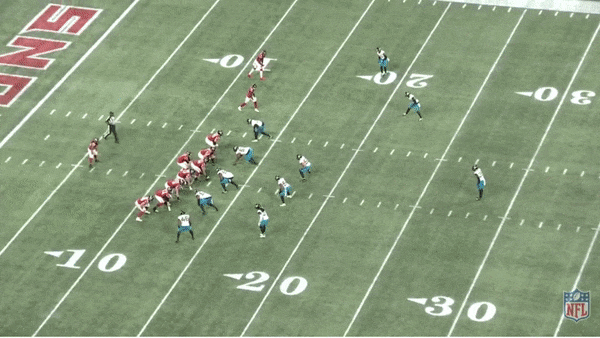
4. Aaron Rodgers and Jordy Nelson, Packers (2008-17)
When Aaron Rodgers thinks about his relationship with Jordy Nelson, two aspects stand out above the rest. One is how they could always find each other during the Packers’ patented scramble drill, especially near the goal line. Whenever Rodgers would bounce around in the pocket or extend plays on the run, Nelson always seemed to know exactly where to be. In 2016, Nelson caught nine touchdowns inside the 10-yard line. No other player in the league had more than six. “I had fellow quarterbacks and coaches in the offseason who’d ask, ‘Do you guys just call scramble drill?’” Rodgers says. “‘Because that’s basically what your red zone offense is: Find Jordy.’ For years, that’s what it is. It was off-schedule plays where he’d make the right reaction, and he’d make a play.”
During Nelson’s career, no receiver in the NFL had a better understanding of how to navigate traffic as plays broke down in the red zone. “For whatever reason, I enjoyed working the back line of the end zone,” Nelson says. “Just trying to get lost behind the defenders. Once the eye contact was made or once I saw that void, I’d attack that area.” It may have seemed like he and Rodgers had a telepathic link on those plays, but Nelson says that feel came from hundreds of practice reps. During special teams periods, the Green Bay offense would work on their goal line scramble drill. And as Nelson watched the way his quarterback moved, he figured out exactly when Rodgers would be ready to throw the ball after he broke the pocket. “A lot of the time, he steps up inside the tackles,” Nelson says. “And then when he gets out of the pocket, he gets depth and buys some time so he can get his hips and shoulders turned. So if you’re getting open while he’s getting depth, he’s not ready to throw the ball. There’s that time of letting him get out and around, get clear, and then getting open.”
Rodgers brings up a play against the Falcons in 2010, when the Packers were trailing late in the fourth quarter. Nelson was originally supposed to sit down in the middle of the field just over the goal line, as he did on many of Green Bay’s red zone concepts. But as Rodgers escaped to his left, Nelson drifted back toward the end line, dove toward the pylon, and corralled a 10-yard missile to tie the game. “I threw probably the hardest ball I’d thrown in the NFL in my career,” Rodgers says. “And he caught it like it was nothing.”
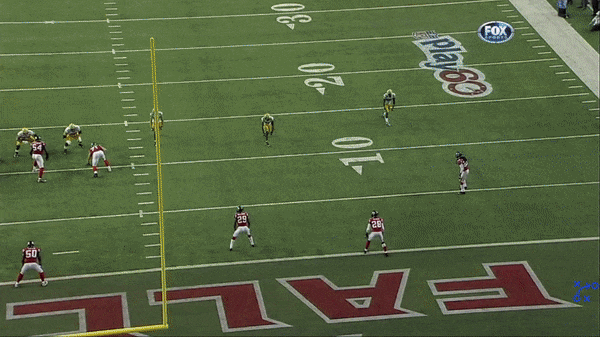
The other aspect that still sticks out for Rodgers is the timing he and Nelson developed over the years. “I always felt like with him, [the timing] was just different,” Rodgers says. “Just really figuring out when he was stopping and starting and where he was gonna be. We were rarely off.” That connection was most apparent on the back-shoulder throws that Rodgers and Nelson became famous for. Their hit rate on back-shoulder throws was so high that people eventually started believing they were baked into the play design. But Nelson insists that was never the case. “It definitely was not planned,” Nelson says. “That was probably the biggest misnomer from our time in Green Bay. Everyone thought the play was like, ‘200 Jet back shoulder.’ Which is incorrect, 100 percent.”
Many of those completions came tight against the sideline, which allowed Nelson to showcase his talent as one of the best boundary receivers the sport has ever seen. When he talks about it now, Rodgers still seems to have trouble processing Nelson’s internal navigation system. “His awareness about where he was on the field was incredible,” Rodgers says. “Always dragging his feet. He would never get pushed out of bounds or run out of bounds on his own. He always had a great feel about how much room to leave for the throw, and where his feet had to be to secure the catch.”
That ESP led to maybe the most improbable completion of the entire Rodgers-Nelson era—a play that includes every facet of their relationship rolled into one highlight. With Green Bay trailing the Niners late during the 2013 season opener, Rodgers escaped out of the pocket and rolled to his left. What started as a scramble drill eventually turned into a back-shoulder fade as Nelson tore down the sideline. As the ball flew his way, Nelson stuck both feet in the ground and extended as far as he could. “I knew the ball was out of bounds, but I just planted my feet on the sidelines and fell,” Nelson says. “If I could reach it, I could reach it.” He did—for a 37-yard gain that set up a go-ahead touchdown. Rodgers has produced huge numbers with plenty of receivers during his career, but his connection with Jordy was truly special.
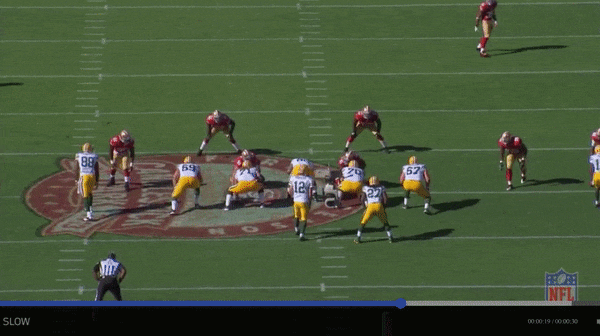
3. Drew Brees and Michael Thomas, Saints (2016-19)
Brees and Thomas haven’t been together as long as the other duos near the top of this list, but what they’ve accomplished in their (relatively) short time together is staggering. Along with breaking the single-season receptions record this year with 149 catches, Thomas has dwarfed nearly every other receiver’s totals in his first four years in the league. His 5,512 career yards put him 116 ahead of Randy Moss. With 470 receptions, Thomas has 70 more than any other player in that time frame. And maybe most ridiculous of all: Thomas has hauled in 78.1 percent of his career targets. No other qualified wide receiver is above 70.2 percent.
Defenses just don’t have an answer for this guy. He and Brees feast on soft coverage, and if teams are naive enough to leave a corner on Thomas one-on-one, he’s arguably the best contested catch receiver in the entire league. “The thing you notice about Mike is that he’s not running a route for the sake of the concept,” says former Saints backup quarterback Luke McCown. “He’s attacking your defense. That’s his mentality: I’m almost running this route angry that you’re even trying to cover me.” McCown was with New Orleans when Thomas was drafted in 2016, and he says that when the rookie arrived, it seemed like he was trying to take on the entire NFL all at once. “It was very clear, the day he stepped foot on campus: ‘This guy plans on turning the league on its head,’” McCown says. “I can’t tell you how many fights were started in the first couple days.”
As a rookie, Thomas made his bones on simple concepts that took advantage of his strength and route-running sense. He consistently hammered defenses on 9-yard hitch routes that allowed him to overpower cornerbacks. “It’s kind of an easy route to get to for a big, physical guy,” McCown says. “Because all you need to do is work a good release, get to the outside shoulder of the defender to get him turned, and swim him to use his momentum against him. It marries up well with Drew because he’s accurate and plays with great anticipation and timing.”
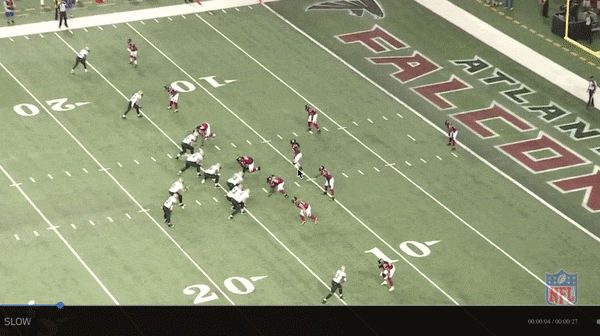
If the boulder-size chip on Thomas’s shoulder was quickly apparent, then so was his talent. Brees had played with several great pass catchers. He crafted a successful partnership with Marques Colston during his early years with the Saints and later turned Jimmy Graham into a touchdown machine. But he’d never encountered anyone like Thomas.
McCown says much like a personnel executive, Brees develops his own individual plans for the Saints’ skill-position players. He selects certain areas to hone with teammates after practice, drilling down on traits that he considered strengths. For Thomas, that list grew quickly. What Brees—and eventually, the rest of the NFL—learned is that Thomas’s potential is limitless. “When you match anticipation and accuracy with a savviness about knowing when a ball is coming, where to sit down in zones, and the ability to attack the ball in flight—as a personnel guy, you couldn’t ask for better on your team,” McCown says. “You couldn’t ask for a better combination of things.”
2. Tom Brady and Rob Gronkowski, Patriots (2010-19)
By the start of his second training camp, it was clear that Gronkowski was ready to blossom from a situational weapon into a full-on force of nature. He caught 10 touchdowns as a rookie in 2010, but it wasn’t until the following year that the beast we know as Gronk was born. “In training camp that year, it was just kind of like, ‘Damn, this kid’s really, really, really good,’” says Danny Woodhead, who played for the Patriots from 2010 through 2012. “Some of the catches he made in practice … he’d be running a seam route, and maybe the ball is a little low, and he’s making a shoe-string catch. The dude’s 6-foot-6. That’s not normal. That doesn’t happen. It’s hard for a guy who’s 5-foot-8 to do that.”
Gronk’s 2011 campaign remains the most dominant season by a tight end in NFL history. He hauled in 90 catches for (a then-record) 1,327 yards. His 17 touchdown receptions are still a single-season record at the position, as is his 10.7 yards per target average. That final number highlights the scope of Gronkowski’s destruction during his career. His impact needs no “for a tight end” caveat. Gronkowski retired with a 9.9 yards per target average over his 10 seasons. That’s the best mark for any player, regardless of position, since targets became an official stat in 1993. Better than Julio Jones (9.68). Better than Jordy Nelson (9.29). Better than Calvin Johnson (8.86).
When Gronk was healthy, no play in football felt more automatic than a throw to him in the red zone. And the scary part is that New England had about a dozen different ways to get him the ball. He’d rumble down the seam and catch a fireball from Brady for a quick-strike score. When teams started accounting for those, Gronkowski would bend his route to the corner and catch a lofted ball near the pylon. He’d sprint into the flat, swat a defender away like a fly, and chug 20 more yards into the end zone. People may have considered Gronk a lovable goofball, but the amount of work that New England put on his plate showed that Bill Belichick and his staff clearly respected his football acumen. “They put him in I don’t know how many different situations,” Woodhead says. “They lined him up everywhere. In order to handle all that, you’ve got to be pretty smart.”
That flexibility put immense strain on defenses, and it also gave the greatest quarterback of all time a baked-in advantage. How teams lined up to defend Gronkowski often tipped off whether they were playing man or zone. Before a single player went in motion—and long before the ball was snapped—Brady had already eliminated half the possible coverages from his mental calculus. In pretty much every way, Gronk was the perfect Patriots weapon.
As Gronk chewed up yardage, he also chewed up the scenery. For a franchise that often seemed devoid of joy, Gronkowski’s beer-chugging, shirtless, one-man party was a welcome change. Yo soy fiesta, indeed.
1. Peyton Manning and Marvin Harrison, Colts (1998-2008)
The Colts’ prolific duo did their best work around the turn of the century, but don’t let time dull you to their accomplishments. Starting in Manning’s second season, Harrison recorded at least 82 catches, 1,113 yards, and 10 touchdowns in eight straight years. That ties Jerry Rice for the most seasons meeting those thresholds in league history. Only 25 receivers have ever hit those marks in at least three seasons.
Those of us under the age of 35 probably best remember the Manning-Harrison duo during the back half of their careers, when they got by with savvy route-running ability and a little snot on the ball. But early in their time together, these two made up one of the best deep-ball combos the league had ever seen. “You might have a vision of Peyton throwing wobblers that had a little lollipop to them,” says Bucs quarterbacks coach Clyde Christensen, who spent 10 years with Manning in Indianapolis. “But that was a couple million throws into this thing. When I go back and watch [tape], I sometimes wonder if it’s the film, but I think, ‘God, this is so fast.’”
One of Indy’s favorite concepts during those days featured a deep post to Harrison off of hard play-action—and the Colts weren’t afraid to dial that up on the first snap of a game. Former Colts offensive coordinator Tom Moore recalls a Monday night game against the Steelers in 2005, when he relayed in the play and knew from the moment Manning broke the huddle that it was going for an 80-yard touchdown. “We opened up quite a few games with takeoffs,” Moore says. “We always told Peyton, ‘If you see something, go for it.’ That was kind of our motto: If you see it, go for it.”
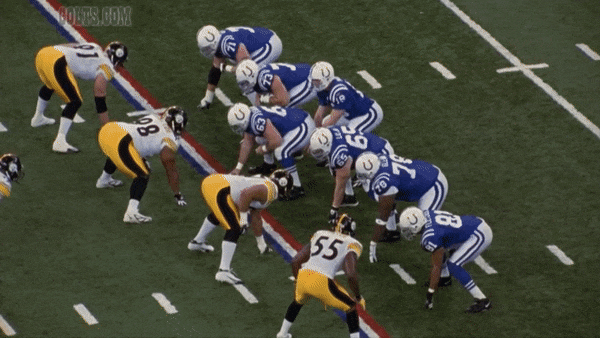
Watching clips of the early 2000s Colts is like being transported back in time. The quality of the gameplay is no different; Manning had an incredible arm early in his career, and 2002 Marvin Harrison could be dropped into next week’s Super Bowl and easily catch a dozen passes from Patrick Mahomes. But the difference in defensive philosophy is staggering. Tampa 2 coverage was all the rage back then, and Indy seemed to have a dozen ways to exploit it. Harrison had an uncanny ability to throttle down between the corner and safety to give Manning room for a hole shot up the sideline. And the moment defenses would account for that deep out, Harrison would cruise past a flat-footed safety for an over-the-top touchdown. “A lot of quarterbacks, you’d tell them through the headset, ‘Hey, this is Cover [blank],’ and it would paralyze ’em,” Christensen says. “Peyton and Marvin had a Pentium processor that was way ahead of its time in terms of handling information fast.”
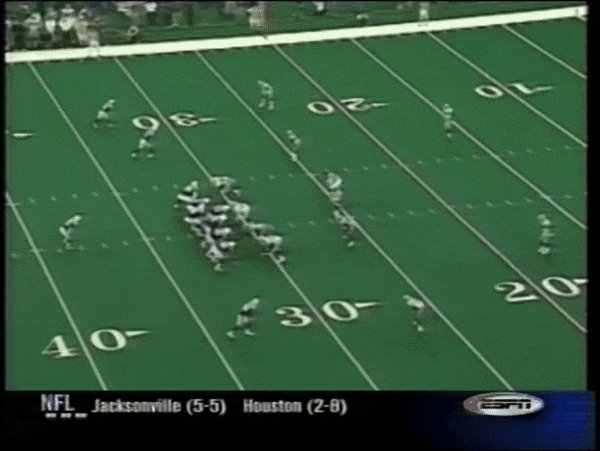
The microchip embedded in Manning’s head sometimes made it seem like he was a robot, mechanically running the lifeless machine that was the Colts offense. But Christensen contends that both he and Harrison put far more artistic flourishes into their work than anyone realizes. Christensen remembers a play against the Jaguars in 2005, when Harrison hit cornerback Rashean Mathis with a fake comeback route for a 65-yard touchdown in the second quarter. The route wasn’t even part of that play. “They would do things that you wouldn’t practice and wouldn’t script,” Christensen says. “I used to always complain because I couldn’t grade the film until I talked to those guys, because you didn’t know what Peyton had told them to do or what Marvin had seen.” Over the past 20 years, no partnership was quite as good for quite as long as the Manning-Harrison duo in Indianapolis.
